The Texas African-American Monument at the Texas Capitol
Introduction
Text-to-speech Audio
The current Texas Capitol, built in 1882-1888, houses the legislative branch for the state of Texas; the building has seen many political changes from 1888-2023. Crafted out of red granite, the Capitol is the 6th tallest capitol building in the United States standing at 302.64 feet from the ground level to the tip of the star of the Goddess of Liberty.[1] The capitol building contains important government offices including both the Senate and House of Representatives’ Chambers, the Legislative Reference Library, and the Governor’s Office.[2] The Capitol also houses monuments located on the Capitol grounds, including the Texas African American Monument.[3] The monument is intended to honor historical figures from all ethnicities and depicts Juneteenth, the emancipation of former slaves, and modern African-American figures that have shaped Texas.[4, 5]
Images
Capitol construction crews surrounding the Goddess of Liberty statue that was later placed on top of the Capitol dome.
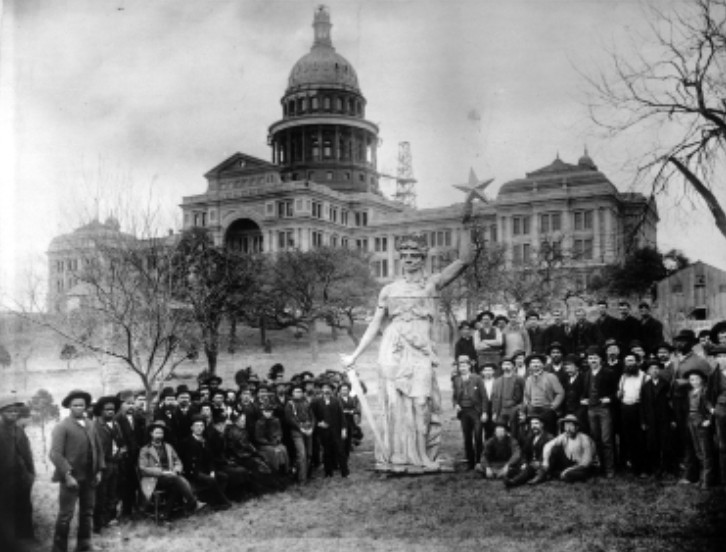
The front of the African-American Monument at the Capitol.
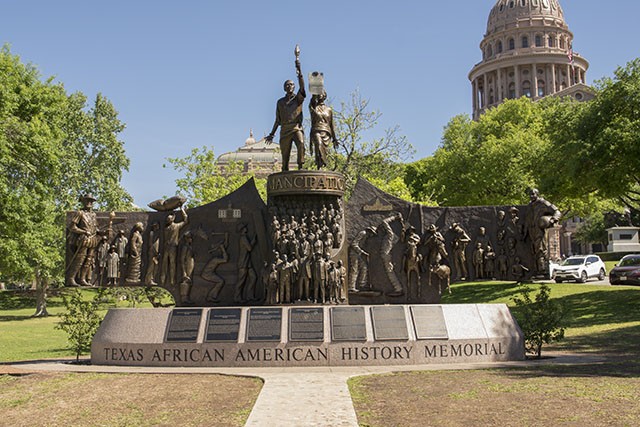
The back of the African-American Monument at the Capitol.
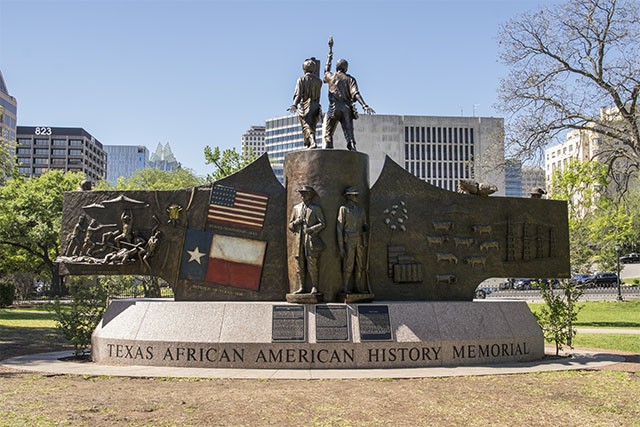
View of a circus parade going down Congress in front of the Capitol. Elephants are pulling carts and the capitol is visible in the background.
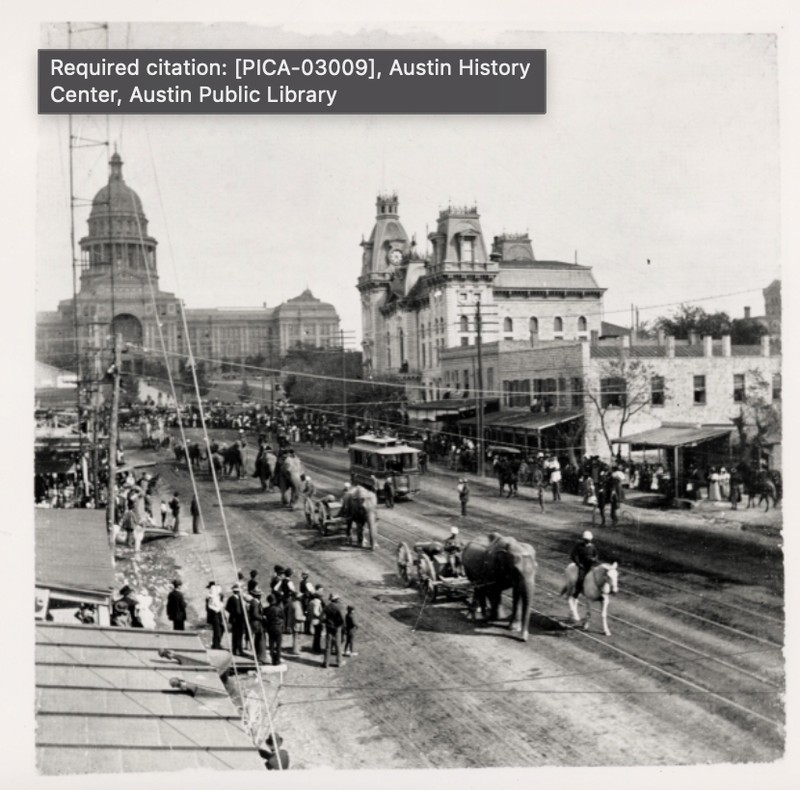
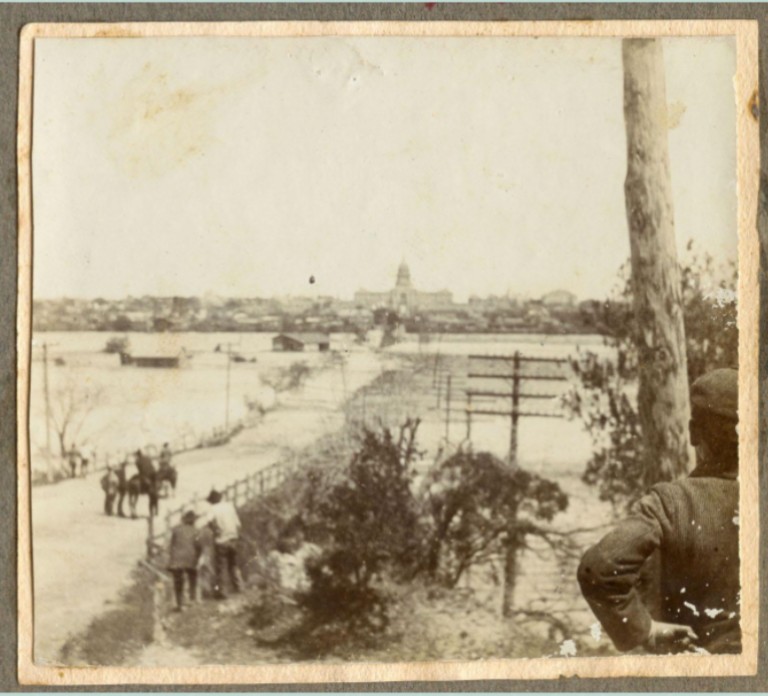
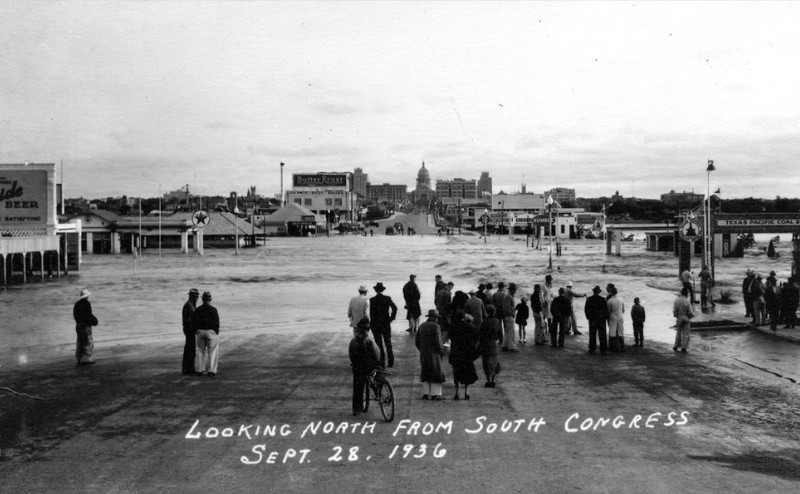
Texas State Capitol
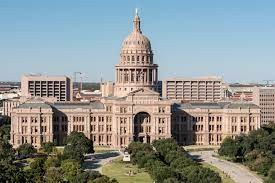
Texas State Capitol At Austin First Floor Blueprint
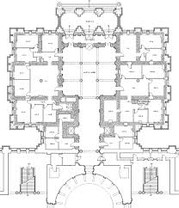
Backstory and Context
Text-to-speech Audio
The Capitol housed a surprisingly diverse group of legislators in the Reconstruction Era during the late 1800s. 52 African-American men served in the legislature during Texas’ Reconstruction Era.[6] 36 of them served only 10-20 years after the Emancipation Proclamation. They participated in a historically and predominately white political field and fought for the basic rights of their communities. Most of the bills introduced by African-American legislature did not get passed but materialized at a later date. During the period of reconstruction, the biracial legislature pushed for public education, resulting in Texas A&M and Prairie View A&M. According to historian Dale Baum these universities "are today the only two tangible achievements of the biracial democracy which was briefly brought to power in Texas by black political activism in the late 1860s and 1870s,".[7] While the biracial legislature of the Reconstruction Era worked well they were also privy to the upcoming separate-but-equal oppression and segregation.
The Capitol was the place where laws were passed that started the period of “separate but equal” segregation. In 1891 the 22nd Legislature passed segregation statutes or what are now known as the Jim Crow laws.[8] Jim Crow laws were used to enforce segregation and allowed punishments to be given when different races intermingled. While Jim Crow laws varied slightly by state, the most common laws prevented marriage between different races and barred shop owners from serving other races.[9] In Texas specifically, the County Education Board was required to build two schools, one for white children and one for black children.[10] While the tour is about the 1928 Masterplan, which was passed by the Austin City council, The Texas legislature was responsible for passing laws (like the Jim Crow laws) that encouraged the ideology that allowed the 1928 Masterplan to get established.
The Texas African-American Monument was erected in 2016 by Ed Dwight, a Denver based sculptor, after a long period of 25 years in legislative deliberation.[11, 12] In 1991 the Texas legislature passed an SCR (Statewide Central Register) to require the State Preservation Board to explore monuments to honor historical figures from all ethnicities. In 1993 an SCR was passed that required the State Preservation Board to include a monument for African-American contributions in their long term master plan for the Capitol grounds.[13] In 1997 a bill was passed that established the Emancipation Juneteenth Cultural and Historical Commission who started to envision the monument. A bill was passed in 2011 expanded the scope of the monument to have a larger representation of African-American culture than just Emancipation. The current monument, constructed out of bronze and granite, was finally unveiled on November 19, 2016. One half of the statue depicts the emancipation of 48 former slaves and the other half focuses on the contributions that African-Americans have made to the state.[14] The statue depicts Barbara Jordan ( first African American elected to the Texas Senate after Reconstruction), Estevanico de Dorantes (the first African to set foot on Texas soil), Hendrick Arnold (a special agent in the Battle of the Republic and in the Indian wars), and Sam McCullough (one of the first casualties of the Texas Revolution).[15, 16]
Sources
- “Texas Capitol (History + Fascinating Facts) - 2023.” Texas News, Places, Food, Recreation, and Life., February 7, 2023. https://texasview.org/texas-capitol/.
- Board, Texas State Preservation. “Texas Capitol.” SPB. Accessed May 15, 2023. https://tspb.texas.gov/prop/tc/tc/capitol.html.
- Board, Texas State Preservation. “Texas African American History Memorial.” SPB. Accessed May 15, 2023. https://tspb.texas.gov/prop/tcg/tcg-monuments/21-african-american-history/index.html
- Cobler, Nicole. “African-American Monument Being Installed at Texas Capitol.” The Texas Tribune, September 27, 2016. https://www.texastribune.org/2016/09/27/african-american-monument-installed-capitol-lawn/.
- “Legislative Reference Library of Texas: New Texas African American Monument.” Legislative Reference Library. Accessed May 15, 2023. https://lrl.texas.gov/whatsnew/client/index.cfm/2017/2/14/New-Texas-African-American-Monument.
- “African American Legislators of the 19th Century.” African American Legislators of the 19th Century | TX Almanac. Accessed May 15, 2023. https://www.texasalmanac.com/articles/african-american-legislators-of-the-19th-century.
- “Conclusions.” Conclusions | TSLAC. Accessed May 17, 2023. https://www.tsl.texas.gov/exhibits/forever/conclusion.html.
- “The 1890s: Jim Crow Laws.” The 1890s: Jim Crow Laws | TSLAC. Accessed May 15, 2023. https://www.tsl.texas.gov/exhibits/forever/endofanera/page3.html.
- “Examples of Jim Crow Laws - Oct. 1960 - Civil Rights.” Jim Crow Museum. Accessed May 15, 2023. https://jimcrowmuseum.ferris.edu/links/misclink/examples.htm.
- “Texas African American Monument.” Legislative Library of Texas
- Cobler, “African-American Monument Being Installed at Texas Capitol.”
- “Texas African American Monument.” Legislative Library of Texas
- Ibid.
- Cobler, “African-American Monument Being Installed at Texas Capitol.”
- Board, Texas State Preservation. “Texas African American History Memorial.”
- Cobler, “African-American Monument Being Installed at Texas Capitol.”
https://ahc.access.preservica.com/uncategorized/IO_0642a4d3-14d2-4579-9d2f-d43fffcfa6e5/
https://tspb.texas.gov/prop/tcg/tcg-monuments/21-african-american-history/index.html
https://tspb.texas.gov/prop/tcg/tcg-monuments/21-african-american-history/index.html
https://ahc.access.preservica.com/uncategorized/IO_4adc1b7e-1778-415d-9951-69c35875f02b/
https://www.davewilsonphotography.com/2016/01/07/texas-state-capitol/
https://openclipart.org/detail/339816/texas-state-capitol-at-austin-first-floor-blueprint
